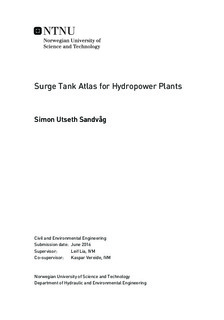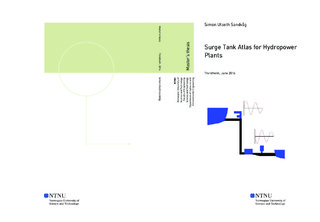| dc.description.abstract | The objective of this master's thesis is to describe the existing surge tank solutions and additional improvements, and to simulate the hydraulic behavior of the surge tanks and how it affects the hydropower plant. The high head hydropower plant Torpa and the low head hydropower plant Åna-Sira are used for the case study, thus the surge tanks can be simulated under different hydraulic conditions. Turbine pressures and mass oscillations after a complete turbine shutdown, and turbine regulation parameters from operating the hydropower plant, are simulated in the LVTrans software.
The result is a \emph{Surge Tank Atlas}, where the surge tank solutions are described with conceptual drawings, advantages and disadvantages, and documentation from the simulations. This Surge Tank Atlas provides a useful tool to compare different surge tank solutions for both a high head and low head hydropower plant.
Some of the conclusions are valid for both hydropower plants and all the surge tank solutions. Increasing the distance from surge tank to turbine, decreasing the surge tank volume or a strong throttling of the surge tank will increase the water hammer significantly, and to some extent reduce the mass oscillations. An optimal throttling of the surge tank will stabilize the running of the hydropower plant, reduce the surge tank mass oscillations and hence the necessary height and volume of the surge tank.
Other conclusions vary between the open and the closed surge tank, and the high and low head hydropower plant. The closed surge tank shows a better dampening of the water hammer than the open surge tank for both hydropower plant, the closed surge tank can be throttled stronger than the open surge tanks, and the surge tanks at the low head hydropower plant requires more volume than for the high head plant, even though the hydraulic head is a tenth of the high head hydropower plant. Hence there are some significant differences in the hydraulic behavior between the surge tank solutions and the high head and the low head hydropower plant, that will be presented and discussed in the Surge Tank Atlas. | |

